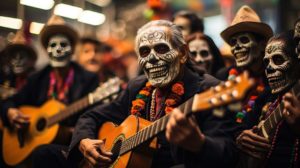
El Día De Los Muertos, or the Day of the Dead, is a festival taking place on November 1st-2nd which celebrates the life and souls of those that have passed on. The holiday is largely celebrated by Mexican and Hispanic communities across the world where families welcome back the souls of their deceased relatives for a brief reunion that celebrates their lives with food, drink, and festivities. We may all be familiar with the skulls surrounded by brightly coloured flowers that are so intrinsically linked with the holiday; however, the history of Día De Los Muertos extends back hundreds of thousands of years to rituals honouring the dead in pre-Columbian Mesoamerica.
On Día De Los Muertos it is believed that the border between the spirit world and the real world is dissolved, and so during this period, the souls of relatives can return briefly to the living world to visit their families. The celebrations see a range of food, drinks and music celebrated to guide the souls back to the living world for this annual reunion. Often gravesites and ofrendas – alters which are often constructed in homes – are covered in the favourite foods of those relatives who have passed on, alongside bright marigolds. These offerings are said to invite and guide deceased relatives to your home and give them sustenance after their long venture from the other side. Marigolds play a crucial role as the petals are thought to guide wandering souls back to their place of rest, alongside smoke from copal incense, which is used to transmit praise and prayers, whilst purifying the areas around the altar.
However, the history of celebrating the dead extends back to pre-Hispanic cultures which saw death as a natural phase of life, and so Aztecs, Toltecs and other Nahua people considered mourning the dead disrespectful. Therefore, traditions were established to celebrate how the dead were still part of the community and their spirits would always be kept alive in memory by their families. Therefore, on Día De Los Muertos these spirits return to earth and remain part of the community to be celebrated for their lives rather than mourning their deaths. Consequently, today’s Day of the Dead celebrations are a mash-up of pre-Hispanic religious rites and Christian feasts.
UNESCO recognised the importance of Día De Los Muertos in 2008 as it added the holiday to its Tangible Cultural Heritage of Humanity List to show the importance of the day in Mexican communities. Whilst the particular customs and scale of the celebrations have evolved with each generation and region, the heart of the festival is to remember and celebrate those who have passed on from this world but continue to be ever-present. Every celebration of life is surrounded by love and respect for their family members past and present as they celebrate life through death.
One of the most familiar images associated with Día De Los Muertos is skulls or skeletons, which are featured heavily in decorations, food and even in costumes on the holiday. The iconic skulls stem from Mexican political cartoonist José Guadalupe Posada who created an etching to accompany a literary Calavera (skull). He dressed his personification of death in fancy French clothing and called it Calavera Garbancera, as an intended social commentary on Mexican society’s emulation of European sophistication, with the phrase “Todos somos calaveras” (We are all skeletons). Then in 1947, artist Diego Rivera featured Posada’s stylised skeleton in his mural “Dream of a Sunday Afternoon in Alameda Park”, which features a skeletal bust in a large feminine hat which was named Catrina – slang for ‘the rich’. Today, the Calavera Catrina, or elegant skull, is El Día De Los Muertos’ most ubiquitous symbol. Consequently, across Día De Los Muertos festivities today you are sure to find plenty of skulls, often with large numbers of people donning skull face paint.
Common alter snacks and beverages include water to refresh souls after their long journeys from the spirit world, as well as Pan de Muerto, which is typically a sweet bread which features anise seeds and is decorated with bones and skulls made from dough. Often the dough bones are decorated in a circle to represent the circle of life. Sugar skulls also prominently feature throughout the celebration and are part of a tradition brought by 17th Century Italian Missionaries which are decorated with crystalline colours. These sugar skulls come in a whole range of styles, sizes and complexities but are hard to miss at any Día De Los Muertos celebration.
Finally, pulque is a sweet, fermented beverage made from agave sap, which is served alongside a thin warm porridge made from corn flour with unrefined cane sugar, cinnamon, and vanilla, as well as hot chocolate. The food at Day of the Dead celebrations invites their relatives in and provides them with refreshments in the real world alongside a range of their favourite snacks, this celebrates both the memory of relatives and shows respect for their relatives’ journeys from the spirit world.
Overall, the Día De Los Muertos is a bright and rich cultural festival which celebrates the legacy and life of family members. Through a range of offerings, music and memory sharing, the celebrations focus on the meaning of family and the cycle of life that we are all part of. Therefore, the Day of the Dead is celebrated around the world by Mexican and Hispanic communities as they welcome in their relatives this November and celebrate death through life.
Sources:
https://www.nationalgeographic.co.uk/travel-and-adventure/top-10-things-know-about-day-dead








